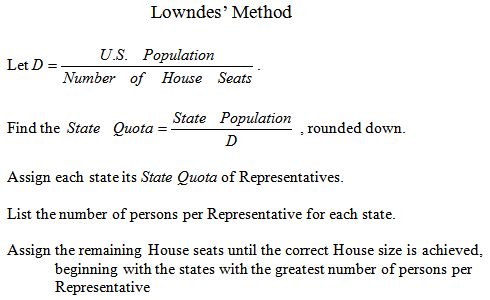- About MAA
- Membership
- MAA Publications
- Periodicals
- Blogs
- MAA Book Series
- MAA Press (an imprint of the AMS)
- MAA Notes
- MAA Reviews
- Mathematical Communication
- Information for Libraries
- Author Resources
- Advertise with MAA
- Meetings
- Competitions
- Programs
- Communities
- MAA Sections
- SIGMAA
- MAA Connect
- Students
- MAA Awards
- Awards Booklets
- Writing Awards
- Teaching Awards
- Service Awards
- Research Awards
- Lecture Awards
- Putnam Competition Individual and Team Winners
- D. E. Shaw Group AMC 8 Awards & Certificates
- Maryam Mirzakhani AMC 10 A Awards & Certificates
- Two Sigma AMC 10 B Awards & Certificates
- Jane Street AMC 12 A Awards & Certificates
- Akamai AMC 12 B Awards & Certificates
- High School Teachers
- News
You are here
Apportioning Representatives in the United States Congress - Lowndes' Method of Apportionment
As the decades wore on, the bias of Jefferson’s method in favor of the larger states was becoming more and more apparent. In 1822, in fact, Representative William Lowndes of South Carolina proposed an alternative procedure:

See the speadsheet 1822 Lowndes for an illustration of Lowndes’ method applied to the results of the 1820 census.
The method never had a real chance of gaining Congressional approval. As you may have seen in the file above, the method would have awarded the remaining 13 seats in the House to the smallest 13 states in the Union. The small states, of course, have very little voting power in the House as compared to the large ones. Jefferson’s method was retained.
Michael J. Caulfield (Gannon University), "Apportioning Representatives in the United States Congress - Lowndes' Method of Apportionment," Convergence (November 2010), DOI:10.4169/loci003163




